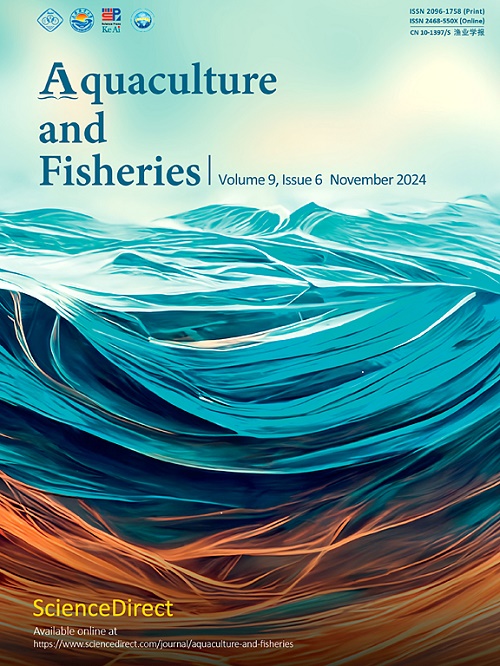Reusing biofloc-culture water and microbubble aeration for culturing the white-leg shrimp Litopenaeus vannamei
Q1 Agricultural and Biological Sciences
引用次数: 0
Abstract
This study investigated the effects of reusing biofloc-culture water for culturing the white-leg shrimp Litopenaeus vannamei. Experiments were conducted for two continuous cycles without water exchange for 30 days during the nursery stage. The studies were performed with two different aeration systems, namely microbubbles (MB) and large air bubbles (LB). Water quality parameters such as dissolved oxygen (DO), temperature, pH, salinity, alkalinity, total ammonia nitrogen (TAN), nitrite, nitrate, settleable solids (SS), and total suspended solids (TSS) were recorded throughout the culture days. Also, comparisons were performed on parameters of the shrimp growth, i.e., body weight and length, feed conversion ratio (FCR), and specific growth rates (SGR) for the 30-day culture for Cycles 1 and 2. Cycle 2 showed no deterioration in water quality and no significant difference in growth performance compared to Cycle 1 for either aeration method (MB and LB). However, when comparing between aeration methods, MB aeration significantly improved the DO of the water and accelerated the conversion of TAN to nitrate. Shrimps in the MB aeration system were significantly larger (by 39%) with a lower FCR value (reduced by 30%) than in the LB aeration system. Harmful bacteria from the Vibro group were detected. However, they occurred at a minimum level in both cycles and aeration types. Overall, the biofloc-culture water might be reused for the subsequent cycle, while the MB aeration might promote the growth of biofloc and L. vannamei.
重复使用生物絮凝培养水和微泡曝气法培养南美白对虾
本试验研究了重复利用生物絮凝水体养殖凡纳滨对虾的效果。苗期连续2个周期不换水30 d。研究采用两种不同的曝气系统,即微气泡(MB)和大气泡(LB)。在整个培养过程中记录溶解氧(DO)、温度、pH、盐度、碱度、总氨氮(TAN)、亚硝酸盐、硝酸盐、可沉降固形物(SS)和总悬浮固形物(TSS)等水质参数。并比较了第1和第2周期30 d的对虾生长参数,即体重和体长、饲料系数(FCR)和特定生长率(SGR)。两种曝气方式(MB和LB)在循环2中均未出现水质恶化,生长性能与循环1无显著差异。然而,在不同曝气方式的对比中,MB曝气显著提高了水体的DO,加速了TAN向硝酸盐的转化。与LB曝气系统相比,MB曝气系统对虾体型显著增大(增加39%),FCR值显著降低(减少30%)。检测了Vibro组的有害细菌。然而,在循环和曝气类型中,它们都发生在最低水平。综上所述,生物絮团培养水可在后续循环中重复使用,而MB曝气可促进生物絮团和凡纳梅的生长。
本文章由计算机程序翻译,如有差异,请以英文原文为准。
求助全文
约1分钟内获得全文
求助全文
来源期刊

Aquaculture and Fisheries
Agricultural and Biological Sciences-Aquatic Science
CiteScore
7.50
自引率
0.00%
发文量
54
审稿时长
48 days
期刊介绍:
 求助内容:
求助内容: 应助结果提醒方式:
应助结果提醒方式:


